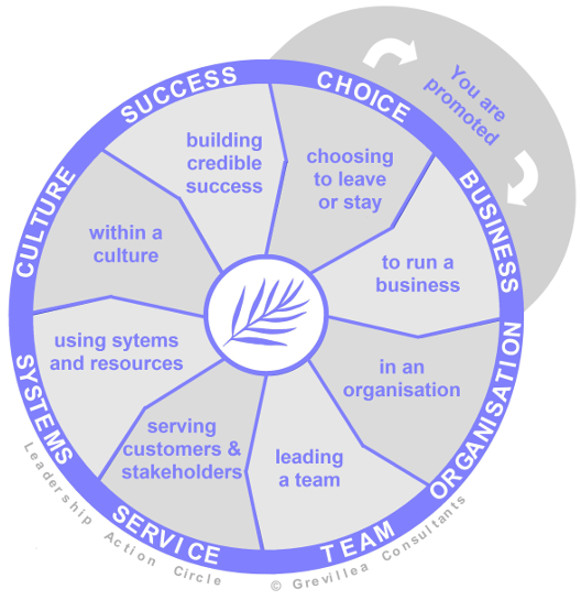Leaders in Transition Overview
The circle has eight internal areas with a ninth, outer area, which is the context of being appointed into a role.
You are promoted, which is the context that initiates the transition into the new role. It triggers a set of predictable phases, risks and opportunities. Recognising the change you are going through and adapting to it is important.
To run a business is the obvious purpose of the leadership role. The business could range from that of a work team to that of a whole organisation, depending on the level of the leader's role. Getting to know the business early is an important part of the transition.
In an organisation, which is an important fact of the transition. The new role is not just about the technical content of the business. It is about how it gets done in the organisation, with its people, resources and politics.
Leading a team is about the fundamental requirement of the leadership role. It is to help a group of people, small or large, to succeed in their work. This is important for them and the organisation.
Serving customers and stakeholders keeps the focus on how the team or organisation will foster the relationships it relies on. Creating value, emotional engagement and customer loyalty are important for everyone's benefit. The leader has to invest in these as part of the transition.
Using systems and resources draws attention to the technical requirements that underpin the team or organisation's ability to get the job done. A leader has to learn how to get the best technical outcome. The more senior the leader the more challenging this is as they have to supervise more and more activity beyond their own technical expertise.
Within a culture pays attention to the fact that technical excellence and analytical knowledge of the business are insufficent to ensure a successful transition or thriving business. The leader must learn how decisions, actions and results are interpreted by people in the organisational culture. A correct outcome acquired while sending out the wrong signals can undermine the result.
Building credible success points to the goal of the transition: believable postive results. The leader has to bring the team or organisation to a successful outcome, engaging key stakeholders, meeting business targets and achieving the many other requirements they must meet. All of this must be achieved and demonstrated to be a success.
Choosing to leave or stay comes serveral time during the transition. An early decision to leave indicates a possible failed transition for the leader and/or the organisation. But once a successful transition has been achieved the leader and the organisation have to decide whether they seek further promotion or stay in the role.
The Leadership Action Circle may be a cycle that a leader goes through many times in their career. For some, they will go through it only once or twice if they find their niche early. At all times the transition is fraught with risk, tripping up a large number of leaders and organisations. Paying attention to each of these areas can help reduce the risk and accelerate the movement to success.
